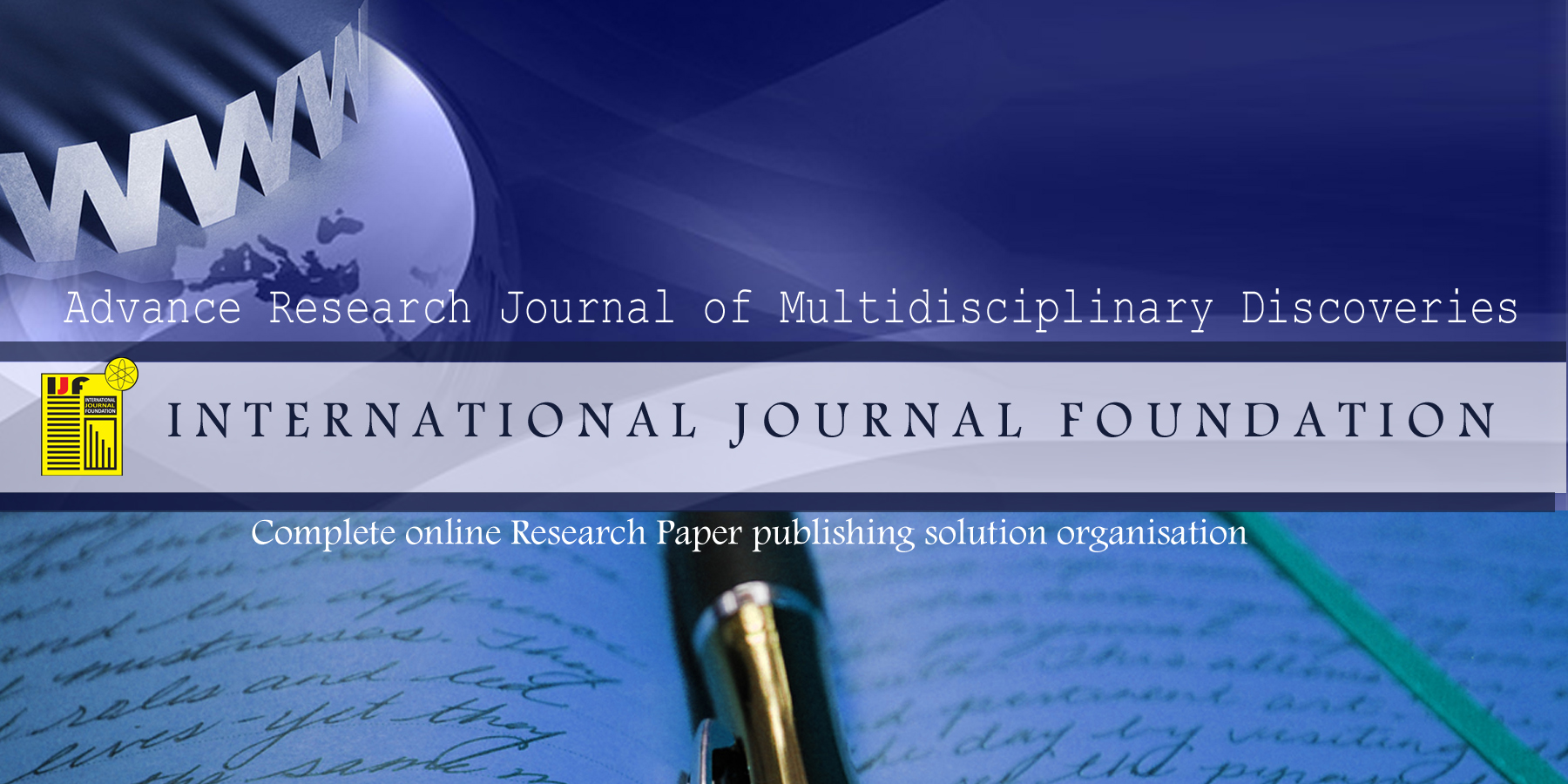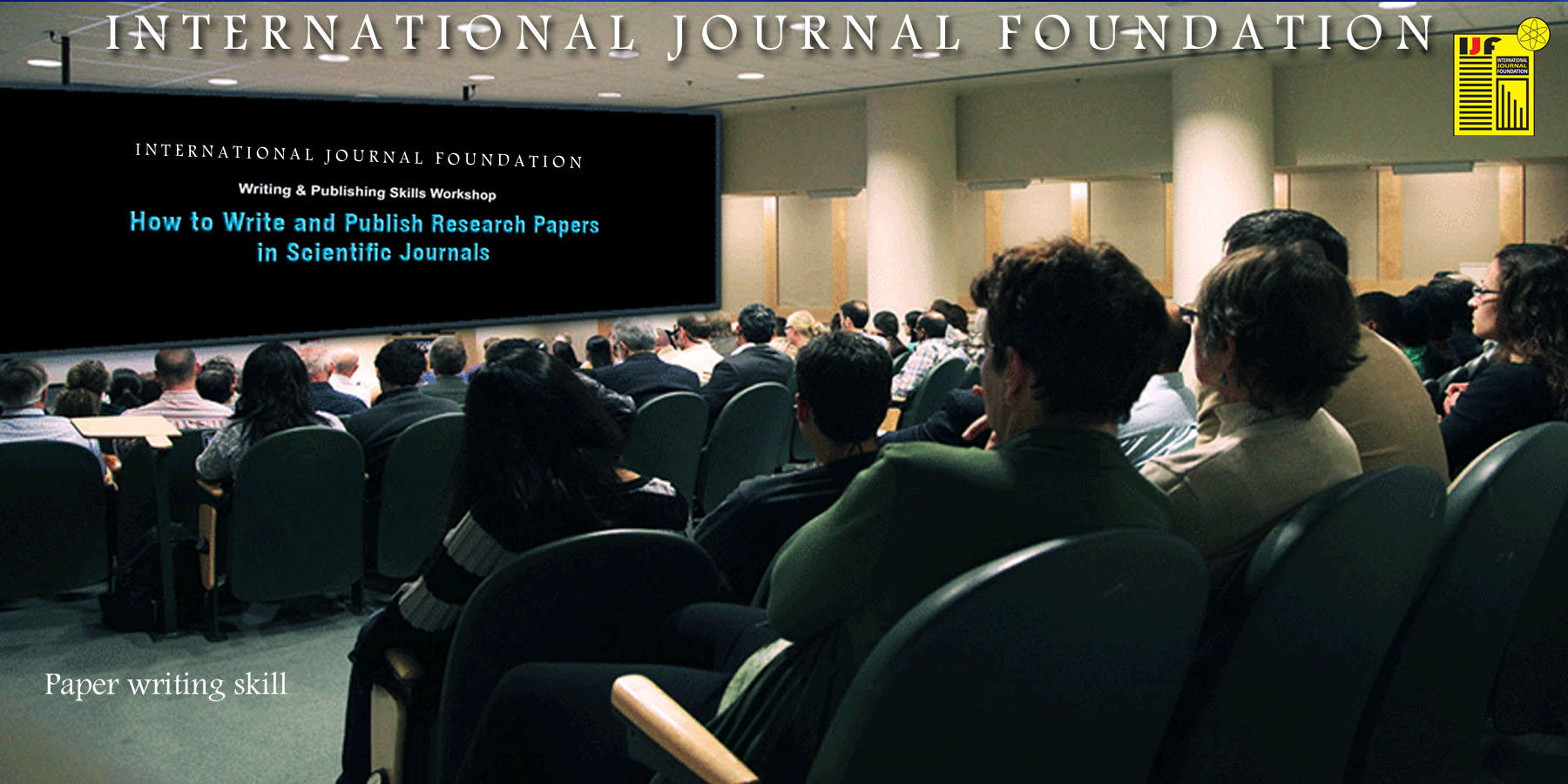2019
NOVEMBER 2019/ Vol.43.0/ Issue-I
CATEGORY : Research Topic on Chemical Science [ Original Research Article ]
| SL.No. | Detailed information of the published article |
| 1 | Manuscript Title : Elemental Analysis of Cassava Effluent from Some Cassava Processing Centres in Iwo, southern Nigeria as determined by Atomic Absorption Spectrometry. Author’s Name : * O. O. Adejumo1, A. O. Oyelowo2 Article Type : ORIGINAL RESEARCH ARTICLE Country from : NIGERIA Date of Publication: 20-12-2019 Journal Name : Advance Research Journal of Multidisciplinary Discoveries [ ISSN : 2456-1045 ] Article Identification : Vol. 43.0/Issue-I/Chapter-I/Page – 01-03 [NOVEMBER-2019 EDITION ] Article Code : CHEM-V43-I1-C1-NOV2019 Status : Officially published Publisher : International Journal Foundation Download PDF : Full article (Pdf) —————————————————————————————————————————– ABSTRACT: This study determined the levels of trace elements in cassava effluent obtained from Iwo, South west Nigeria, using Atomic Absorption Spectrometric technique. Removing toxic effluent from fermented and compressed cassava has been known to enhance detoxification of cassava products. click here However, increased demand for Gari, a creamy-white granular flour made from cassava tubers makes some commercial gari processing centres in Iwo process in a hurry without allowing for sufficient fermentation to cause appreciable cyanide reduction. Cassava effluent samples were collected from some cassava processing centres in Iwo and prepared for laboratory analysis by filtration process. The samples were analysed with a PG 990 Atomic Absorption Spectrophotometer. The mean concentration of the elements in the cassava effluent samples show the presence of the following: Manganese (0.15 ± 0.126 mg/kg), Zinc (not detected), Lead (not detected), Iron (74.30 ± 0.150 mg/Kg), Copper (not detected) and Magnesium (257.80 ± 0.250 mg/Kg). This result showing relatively high concentration values for Magnesium and Iron in the cassava effluent might be a source of increased toxicity levels in humans. This emphasize the need for commercial gari processing centres to exercise enough patience by strict observance of the stipulated period for the fermentation process to detoxify cassava.KEYWORDS : Atomic absorption spectrometry, Cassava effluent, Concentration, Detoxification, Elemental Analysis, Trace Elements.

|
CATEGORY : Research Topic on Medical Science [ Original Research Article ]
| SL.No. | Detailed information of the published article |
| 2 | Manuscript Title : Assessment of Some Ascitic Fluid Biochemicals in Ascites Cirrhotic and Non-cirrhotic Patients : A Pilot Study in El-Gazera state in Sudan. Author’s Name : Marwa Gubara Hamed1 , *Nuha Eljaili Abubaker2 , Mariam Abbas Ibrahim3 Article Type : ORIGINAL RESEARCH ARTICLE Country from : SUDAN Date of Publication: 20-12-2019 Journal Name : Advance Research Journal of Multidisciplinary Discoveries [ ISSN : 2456-1045 ] Article Identification : Vol. 43.0/Issue-I/Chapter-II/Page – 04-08 [NOVEMBER-2019 EDITION ] Article Code : MDS-V43-I1-C2-NOV2019 Status : Officially published Publisher : International Journal Foundation Download: Full article (Pdf) —————————————————————————————————————————– ABSTRACT :Background: Ascites is a consequence or complication of many primary diseases, in particular cirrhosis.Objectives: This study aimed to assess ascetic glucose, albumin and total protein levels in patients with ascites.Materials and Methods: In this cross-sectional study; one hundred and twenty patients diagnosed with ascites, aged between 40 – 60 years were enrolled in this study (60 patients had ascites with liver cirrhosis and 60 non-cirrhotic patients with ascites), during a period from April to September 2018, estimation of ascitic glucose, albumin and total protein were done by Mindray 380; the obtained data were then analyzed by SPSS version 21.click here Results: The results revealed a significant increase in ascetic glucose and total protein levels in ascites patients with liver cirrhosis when compared to ascites patients without liver cirrhosis (P-values: 0.00, and 0,000 respectively), in contrast there was a significant decrease in ascetic albumin level (P-value: 0.02). The glucose level was positively correlated with age (R-values = 0.266, P-values = 0.04). The glucose, total protein levels were positively correlated with duration of disease (R-values = 0.696, P-values = 0.000) (R-values = 0.431, P-values = 0.001) respectively.Conclusion: Patients with ascites and cirrhosis had high glucose and total protein levels. The use of ascetic fluid analysis is helpful to make an accurate diagnosis of cause of ascites.KEYWORDS : Ascitic fluid analysis, Ascites, Cirrhosis, non Cirrhotic patients, Sudanese patients..

|
CATEGORY : Research Topic on Medical Science [ Original Research Article ]
| SL.No. | Detailed information of the published article |
| 3 | Manuscript Title : The effect of access, perception of benefits, and patient satisfaction on the utilization of health services. Author’s Name : * Rahman, Abdur1, Muhyi, Ruslan2, Arifin, Syamsul3, Husaini4, Ilmi, Bahrul5 Article Type : ORIGINAL RESEARCH ARTICLE Country from : INDONESIA Date of Publication: 20-12-2019 Journal Name : Advance Research Journal of Multidisciplinary Discoveries [ ISSN : 2456-1045 ] Article Identification : Vol. 43.0/Issue-I/Chapter-III/Page – 09-15 [NOVEMBER-2019 EDITION ] Article Code : MDS-V43-I1-C3-NOV2019 Status : Officially published Publisher : International Journal Foundation Download: Full article (Pdf) —————————————————————————————————————————– Abstract : There are four First Level Health Care Facilities (FLHC) in Murung Raya Regency which implement a Commitment Based Capitation system (CBC) where the utilization of health services in the FLHC can be seen from the Contact Figures (CF) of each public health center. Each of these public health center has a Contact Number (CN) value ie Puruk Cahu public health center at 36.44%, Puruk cahu Seberang Public Health Center at 46.36%, Konut Public Health Center at 3.14% and Muara Laung Public Health Center having the lowest contact number at 17 , 35%.. click here One indicator to assess how the use of Public Health Center as a health service center by the community is the number of visits to the public health center or not. The low number of community visits to health care centers shows that the community is not utilizing the health services. Based on the data above, it is known that the Muara Laung Public Health Center has the lowest contact number so that it can indicate that the community is still not utilizing the health services at the Muara Laung Public Health Center. The purpose of this study was to analyze the effect of access, perceived benefits, and patient satisfaction on the utilization of health services in the Work Area of Muara Laung Public Public Health Center, Murung Raya Regency. This research is a quantitative study with cross sectional study design to examine the influential factors (independent variables), namely the effect of access, perceived benefits, and patient satisfaction on the utilization of health services (dependent variable). The number of samples in this study was 113 with a systematic random sampling technique. The results showed there was an influence between access (p = 0.032), perceived benefits (p = 0.020), patient satisfaction (p = 0.011), on the utilization of health services. While the most dominant factor influencing the utilization of health services is satisfaction (p = 0.012) (Exp (B) = 2.643). The conclusion of this study is that there is an influence between access, perception of benefits, patient satisfaction with the utilization of health services, with the most dominant factor influencing the utilization of health services is satisfaction. . KEYWORDS: Access, Perception of Benefits, Patient Satisfaction, Utilization. 
|
CATEGORY : Research Topic on Medical Science [ Original Research Article ]
| SL.No. | Detailed information of the published article |
| 4 | Manuscript Title : Endoluminal Vacuum Therapy : A clinical case of 7-year-old child with an Iatrogenic Esophageal Perforation. Author’s Name: * N.Kartulev1, H.Shivachev2, Y.Pahnev3, Z.Antonova4, V.Oparanova5 Article Type : ORIGINAL RESEARCH ARTICLE Country from : BULGARIA Date of Publication: 20-12-2019 Journal Name : Advance Research Journal of Multidisciplinary Discoveries [ ISSN: 2456-1045 ] Article Identification : Vol. 43.0/Issue-I/Chapter-IV/Page – 16-19 [NOVEMBER-2019 EDITION ] Article Code : MDS-V43-I1-C4-NOV2019 Status : Officially published Publisher : International Journal Foundation Download: Full article (Pdf) —————————————————————————————————————————– Abstract : Vacuum therapy is a method of treatment of difficult to heal wounds using negative pressure. This method of therapy has been used since ancient times and has undergone lots of modifications. Endoscopic vacuum therapy could be applied intracavitary for the upper and lower gastrointestinal tract and intraluminally for the upper gastrointestinal tract. click here In adult patients the method is successful in more than 75% of cases, while there are still not enough clinical trials on children, the results so far are close to those in adults.We present a clinical case of 7-year-old child with an iatrogenic esophageal perforation. An intraluminal endoscopic vacuum therapy was administered and was enough for a complete closure of the defect and resumption of oral intake at discharge. KEYWORDS: Vacuum therapy, intraluminally, iatrogenic esophageal perforation ,endoscopic vacuum therapy. . 
|
CATEGORY : Research Topic on Medical Science [ Original Research Article ]
N.B: Our publication process is going on. More paper will be added very shortly in this current issue…
(i) To Publish your paper in our upcoming issue send your article directly at article.ijf@gmail.com
![]()
![]()
![]()
![]()
![]()
















